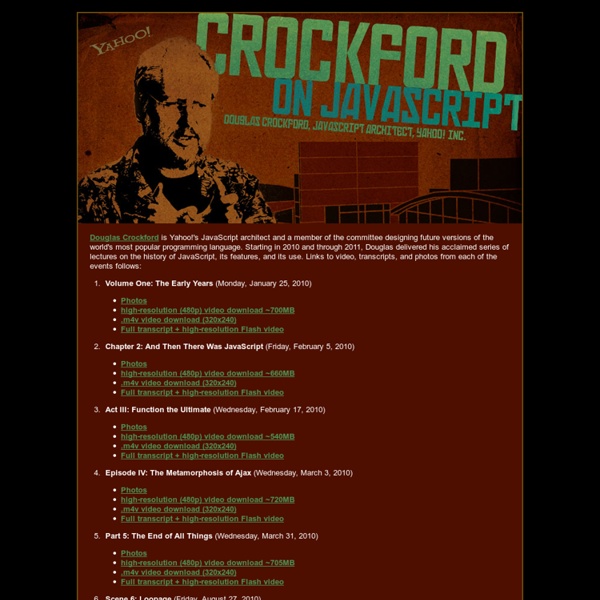



isaacs/slide-flow-control - GitHub A Look at Popcorn Today we’re going to take a look at Popcorn.JS, a library from Mozilla which makes it very easy to manipulate a webpage based on the current position of a video. This allows you to create rich “hypermedia” experiences around your video content. With Popcorn, you could display information about actors currently on-screen, or show Google Street View maps of locations in the video. Take a look at the Demo Page to see what we’ll be achieving – a mix of images, Google Maps, Wikipedia, tagging, RSS feeds, Facebook and web content – all in a 22 second video clip. About Popcorn Popcorn makes video work like the web. Popcorn provides a collection of plugins to easily pull in remote data to the screen. This pulls in the first 40 words from the Queen’s Wikipedia page into the element with an ID of wiki. You can just as easily display a Google Map: This displays a Google Map of England in #map at 10 seconds, and disappears at 12. Getting Started Create your file structure like so: Images Videos Done it?
Script Junkie | Creating Responsive Applications Using jQuery Deferred and Promises Today we’re going to explore the concept of deferreds - an important feature found in JavaScript toolkits such as dojo and MochiKit, which recently also made its debut to popular JavaScript library jQuery. Deferreds offer a solution for abstracting non-blocking elements (such as the response to ajax requests) and achieve this by creating a ‘promise’ which aims to return a response at some point in the future. If you haven’t come across the concept of ‘promises’ before, we'll be covering them in some detail shortly. At a high-level, deferreds can be thought of as a way to represent costly operations which can take a long time to complete. They’re the asynchronous alternative to blocking functions and the general idea is that rather than your application blocking while it awaits some request to complete before returning a result, a deferred object can instead be returned immediately. Promises promise = callToAPI( arg1, arg2, ...) jQuery Deferreds Further Deferreds examples Caching Timing
Smashing Newsletter: Issue #72 Douglas Crockford Javascript Videos Douglas Crockford Javascript Videos 13 flv videos | 246MB+258MB+151MB+167MB+212MB+70MB | Total duration 6hr 24min Yahoo! JavaScript Architect Douglas Crockford covers JavaScript in a series of tutorial and lecture videos. Class 1 - The JavaScript Programming Language Yahoo! Part 1: 30:58 Part 2: 31:08 Part 3: 29:08 Part 4: 19:47 Class 2 - The Theory of the DOM Douglas Crockford teaches "An Inconvenient API: The Theory of the Dom." Part 1: 31:11 Part 2: 21:25 Part 3: 26:24 Class 3 - Advanced Javascript Douglas Crockford teaches "Advanced JavaScript." Part 1: 31:03 Part 2: 25:35 Part 3: 11:01 JavaScript, The Good Stuff Part 1: 39:37 Quality Yahoo! Part 1: 48:22 The State of AJAX Part 1: 38:32
fjakobs/async.js - GitHub Lets Make a 3D Game: microphysics.js This post is part of the “Lets make a 3D game” series. 3D and physics simulation always go well together evenmoresowithmarblegames. One is required for marblesoccer but i wasnt convinced by current 3d physics engines. I explain why at the end. Fortunatly, @pyalot from codeflow.org has been kind enough to write one taylor-made for us: microphysics.js!! It is bite-sized, elegant and efficient. Below is a screencast of me doing a short introduction of the playground. Let’s get started So lets see how to use it. Let’s Create a World Quite a title hey ? Now you start it. The world is now fully initialized. The timeStep parameter is the precision of the physics engine, expressed in seconds. Let’s Add Bodies Don’t worry, this is not about killing people and dispose of their dead bodies :) In physics, A body is a solid object that you put in your world. microphysics bodies can be spheres or static boxes. Now lets add it to our world If you need to remove it, just do world.remove(sphere). Motivation
TinySort About Nibbler - the free website testing tool Want to know more about your website? Enter the address of any website and Nibbler will give you a report scoring the website out of 10 for various important criteria including accessibility, SEO, social media and technology. Nibbler is free and always will be! Get loads of information about your website without having to pay anything. Claim websites & showcase them on your profile After you've tested your website, claim it and add it to your own profile. Customise your profile by uploading your own custom background, or choose from one of our examples. Collect Nibbler badges Websites are awarded badges for cool things. W3C Apprentice Awarded to users when they claim 3 W3C compliant websites. Hot off the press Awarded to sites that have 4 or more feed articles in the past 30 days. HTML5 Maestro Awarded to users when they claim 8 HTML5 websites. Video star Awarded when an embedded YouTube video is found. Multilingual Awarded to sites containing content in more than one language. IE6 Advocate
How does JavaScript .prototype work? kriszyp/node-promise - GitHub Is there a better way of writing v = (v == 0 ? 1 : 0); - Stack Overflow - Vimperator